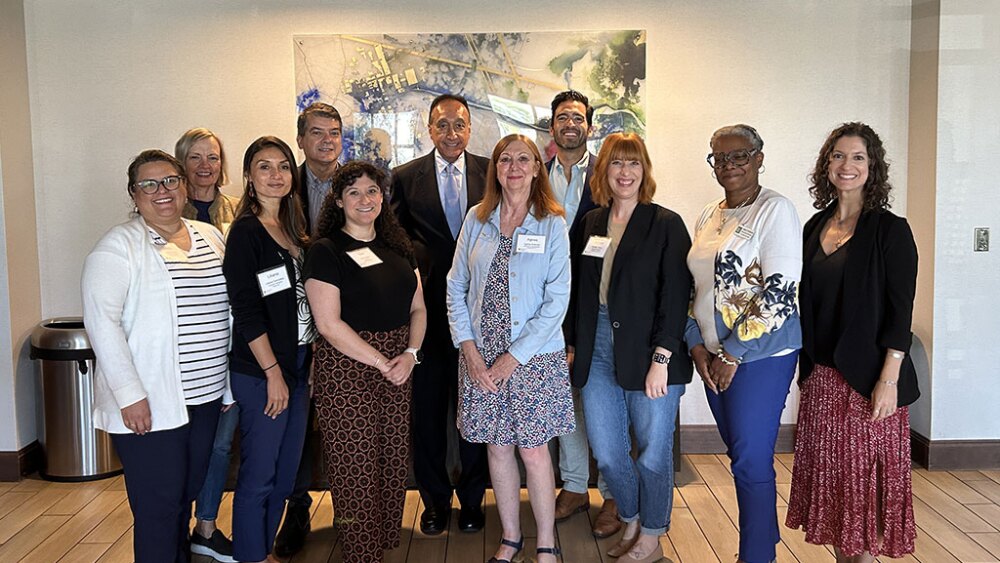A team of ULI experts visited Fort Worth in September 2024 to develop anti-displacement strategies for the city’s historic, majority Hispanic Northside neighborhood, which faces mounting pressure from two nearby megadevelopments, as well as broader metropolitan growth trends that drove up the area’s property values 60 percent from 2016 to 2021.
Sponsored by the Fort Worth Hispanic Chamber of Commerce and the city of Fort Worth, with further support from the ULI Foundation and the ULI Dallas–Fort Worth District Council, the ULI Advisory Services Panel delivered recommendations formulated to keep housing affordable for Northside’s residents and to combat displacement and potential erosion of neighborhood character.
Abutting two developments
The Northside neighborhood sits near Fort Worth’s downtown district and two of the city’s most significant development projects. To the northeast, the Fort Worth Stockyards mixed-use entertainment complex draws thousands of visitors daily and is slated for a major expansion. To the southeast lies the 190-acre (77 ha) Panther Island, where a long-term flood control project is underway that will create new waterfront development opportunities. Eighty percent of Northside’s residents identify as Latino and have great pride in their local culture. The median household income there is $44,991, though—substantially lower than the citywide median household income of $72,726.
This positioning creates what Fernando Costa, Fort Worth’s assistant city manager at the time of the panel, describes as a two-sided coin: “Development at Panther Island and the Stockyards can provide the basis for revitalization and reinvestment in the Northside,” he says. “The other side . . . of course, is that it could cause displacement of businesses and residents. The Northside is at risk of losing much of its heritage, only to be replaced by generic development that would have no particular relevance to its residents.”
The effort to combat displacement arose from an earlier initiative to bolster Northside’s commercial strengths. In 2022, the Historic Northside locale was named one of Fort Worth’s first two Main Street pilot program corridors, managed by the Fort Worth Hispanic Chamber of Commerce. Anette Landeros was president and CEO of the Hispanic Chamber when the organization was selected to work with the city and Main Street America on a project to galvanize commercial revitalization along North Main Street.
During community outreach, residents expressed their concerns about displacement. “We wanted to talk about empty business fronts and boarded-up buildings, and how we could work together to create a vibrant commercial corridor,” Landeros says. “But every time we were trying to generate an energetic conversation to demonstrate the possibilities, there was always a hard stop, because that wasn’t what they wanted to talk about. They wanted to talk about displacement.”
This community resistance led Landeros to speak to elected officials and community leaders in search of answers. When she reached out to Costa, he suggested engaging ULI’s Advisory Services Program.

ULI panelists and staff met with former H.U.D. Secretary Henry Cisneros during the panel week. Left to right: Laura Cortez, Lucia Garsys, Liliana Gonzalez, Antonio Fiol-Silva, Danielle Giarla, Henry Cisneros, Agnès Artemel, Omar Gonzalez (Panel Chair), Ashley Terry, Tamela Thornton (ULI Dallas Fort Worth), and Lauren McKim Callaghan (ULI Advisory Services).
ULI
Building trust
Even before the panel assembled, the city and the Hispanic Chamber engaged in extensive preliminary community engagement. The sponsors raised additional funds to hire community engagement experts to reach residents who had historically been disengaged from civic processes, Costa says.
Dee Lara O’Neal, Main Street project manager with the Hispanic Chamber, conducted 18 community meetings in the weeks leading up to the panel. The engagement revealed both deep concerns about displacement and strong community pride.
“A lot of the comments were, ‘preserve our culture,’ O’Neal says. “Cultural displacement was a real concern. At one of the church meetings, a gentleman told us, ‘It’s not that we don’t love nice neighborhoods and nice amenities. We just want to be able to stay in—and afford—our homes.’”
ULI Dallas–Fort Worth also conducted an UrbanPlan exercise approximately three weeks before the Advisory Panel’s arrival. “It was designed to help community members understand decisions that city officials make, identify what decisions community stakeholders can influence, and how those processes need to work together . . . to move engagement forward in a transparent and collaborative way,” says Tamela Thornton, executive director of ULI Dallas–Fort Worth.
The community engagement efforts generated high levels of participation once the Advisory Panel began. “By the time the panelists were in town, we had such a tremendous response from the community to participate in those focus groups,” O’Neal says.
Key recommendations
The panel proposed a fundamental reframing of the community’s relationship to surrounding development. Rather than viewing Northside as a victim of external forces, the panel positioned the neighborhood as a catalyst for positive change.
“People keep asking, ‘How is Northside going to be affected by Panther Island and the Stockyards?’” says Omar Gonzalez, director of development for Oxbow Development Group in San Antonio and chair of the Advisory Services Panel. “But what if we put Northside at the center of the topic and asked how Northside could benefit from what’s happening around it?”
The panel delivered comprehensive recommendations addressing both immediate concerns and long-term preservation strategies. Central to them was the establishment of a community action committee—a group of residents, businesspeople, and representatives from various community-based organizations who would receive stipends to serve as neighborhood liaisons and advocates. Recently, the North Texas Community Foundation provided a grant from its BEACON (Building Economic Access, Community, Opportunity & Networks) Fund to enable the formation of this crucial governance structure, O’Neal says.
Other major recommendations include creating a Northside cultural and arts district at the state level; investing in key cultural assets and expanding opportunities to celebrate the neighborhood’s heritage; launching an affordable neighborhood fund, potentially with the help of tax increment financing; developing “missing middle” housing—duplexes, triplexes, townhouses, and small apartment buildings—that increase housing supply while maintaining neighborhood scale; and strengthening local businesses. The panel also emphasized the importance of providing property tax relief, because displacement often occurs when longtime residents on fixed incomes cannot afford rising property taxes.
This paradigm shift proved transformative for community members. “When the panel shared their initial findings, I could see the folks in the room breathe a sigh of relief,” O’Neal says. “I think they were impressed with how holistic the approach was.”
Ongoing challenges
Implementation faces several challenges, particularly around funding and maintaining leadership continuity. “So often, it comes down to funds,” Gonzalez says, adding that “leadership is probably more important than funding, because good leaders can find funding.”
Recognizing these challenges, ULI Dallas–Fort Worth took an unusual step by committing implementation funding. “We want to ensure that the Advisory Services Panel’s recommendations don’t just sit on the shelf,” Thornton says.
The Hispanic Chamber’s subsidiary nonprofit organization is working toward independence as a 501(c)(3) that will drive ongoing revitalization efforts. Meanwhile, the Hispanic Chamber continues its Main Street America work focused on commercial corridor stabilization and is pursuing rezoning of North Main Street.
Costa emphasizes the importance of getting ahead of development pressures rather than simply reacting to them: “The development [at] Panther Island and at . . . the Stockyards represents a kind of tsunami. We need to be proactive, and that’s what the ULI panel has helped us to understand. We need to get ahead of this wave that’s approaching the Northside.”
For other communities facing similar pressures, the Fort Worth Advisory Panel’s recommendations offer a framework for engaging residents as partners, rather than as victims, in their neighborhood’s evolution, and for helping to ensure that development benefits flow to existing residents instead of displacing them.
This work was made possible through the support of the ULI Foundation and the generosity of ULI members—whose expertise, engagement, and philanthropic contributions help bring important community efforts like this one to life.






